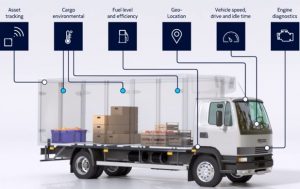What are the most common use cases for sensors and IoT in Fleet Management?
Companies with large fleets of vehicles have found several uses for IoT and sensors, including:
- Driver behavior monitoring
- Fuel monitoring
- Loss prevention
- Predictive fleet maintenance
Each of these helps companies operate their fleets more efficiently.

Driver behavior monitoring
Sensors used to monitor driver behavior give businesses a great deal of insight into how their drivers fare on the roads.
This goes beyond simple accountability. Companies can now monitor items such as how often a driver idles, brakes, drifts out of lanes, etc., allowing them to plan measures to help their drivers be both more efficient and also safer on the road.
Fuel monitoring
In addition to driver monitoring, companies can also use IoT sensors to monitor fuel levels in each vehicle. Abnormal fuel usage rates may indicate leaks or efficiency issues in the vehicle, alerting managers to potential maintenance needs. Thus, fuel monitoring is a powerful predictive maintenance tool.
In addition, a sudden drop in fuel could indicate fuel theft, enabling companies to better protect their mobile assets and recover from losses.
Loss prevention
Monitoring systems allow fleet managers to keep a close eye on conditions within the vehicle. For instance, sensors can detect when doors open or when temperatures change in climate-controlled vehicles. This alerts fleet managers to potential product loss or theft.
These sensors can also help alert fleet managers to maintenance needs. For example, if the temperature tends to rise too much in a refrigerated truck, there could be an issue with the refrigeration system that needs to be taken care of.
Predictive fleet maintenance
Most of the monitoring systems used in fleet vehicles—including the aforementioned fuel monitoring, driver monitoring, and loss prevention systems—can be used in predictive maintenance. Additional sensors used to monitor the engine, tire pressure, and other components of the vehicle add to the data used in anticipating upcoming maintenance needs.
For example, GPS data indicating slow braking by the driver combined with other sensor readings could indicate that there’s an issue with the brake system. Excessive fuel usage combined with engine readings might indicate a developing problem that’s impacting fuel efficiency.
By analyzing the data, it’s possible to predict when proactive maintenance is needed on fleet vehicles, allowing fleet managers to cut down on maintenance costs.
Want to keep reading?
What is Fleet Maintenance? Benefits & Examples of Fleet Maintenance
Modern Fleet Management and Maintenance Software
What are the most common use cases for sensors and IoT in Fleet Management?
4,000+ COMPANIES RELY ON ASSET OPERATIONS MANAGEMENT
Leading the Way to a Better Future for Maintenance and Reliability
Your asset and equipment data doesn't belong in a silo. UpKeep makes it simple to see where everything stands, all in one place. That means less guesswork and more time to focus on what matters.

![[Review Badge] Gartner Peer Insights (Dark)](https://www.datocms-assets.com/38028/1673900494-gartner-logo-dark.png?auto=compress&fm=webp&w=336)
